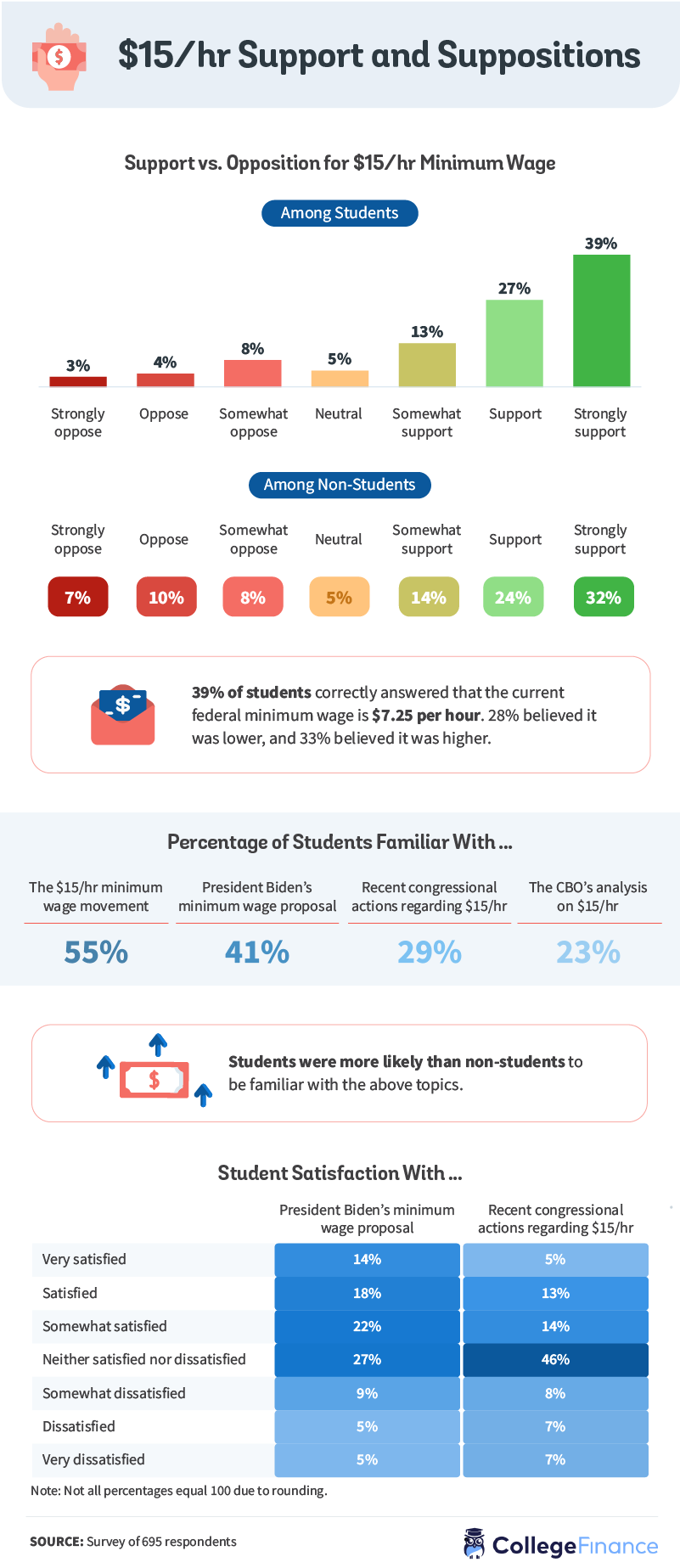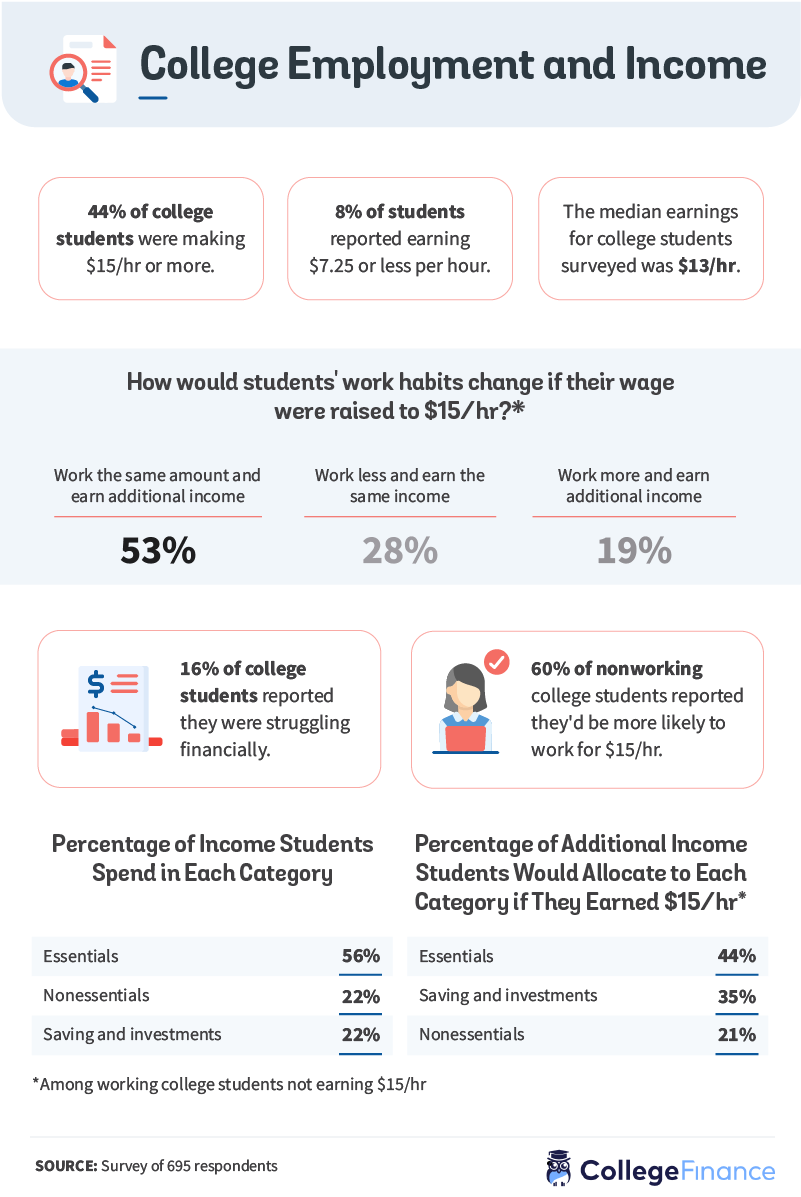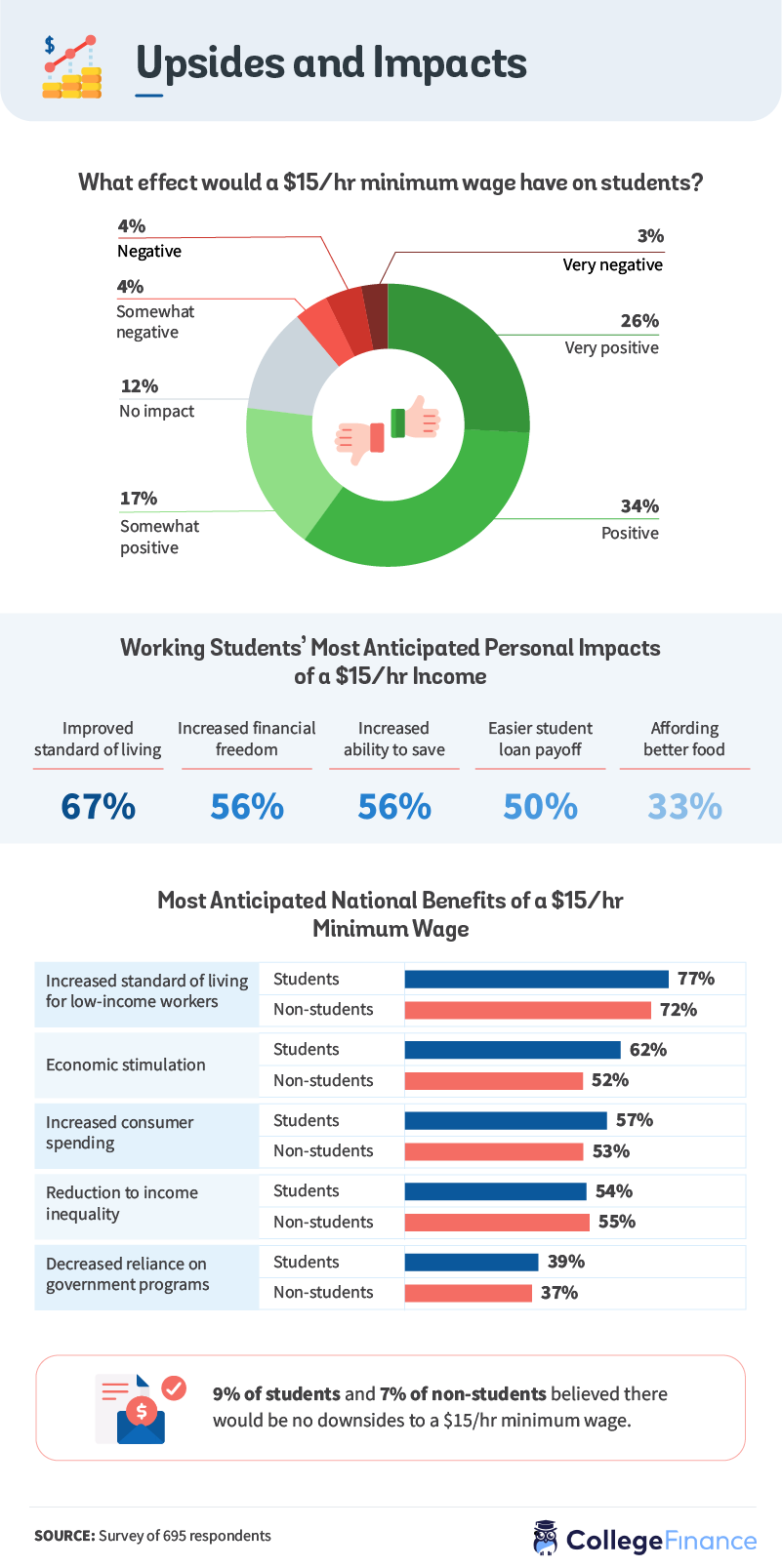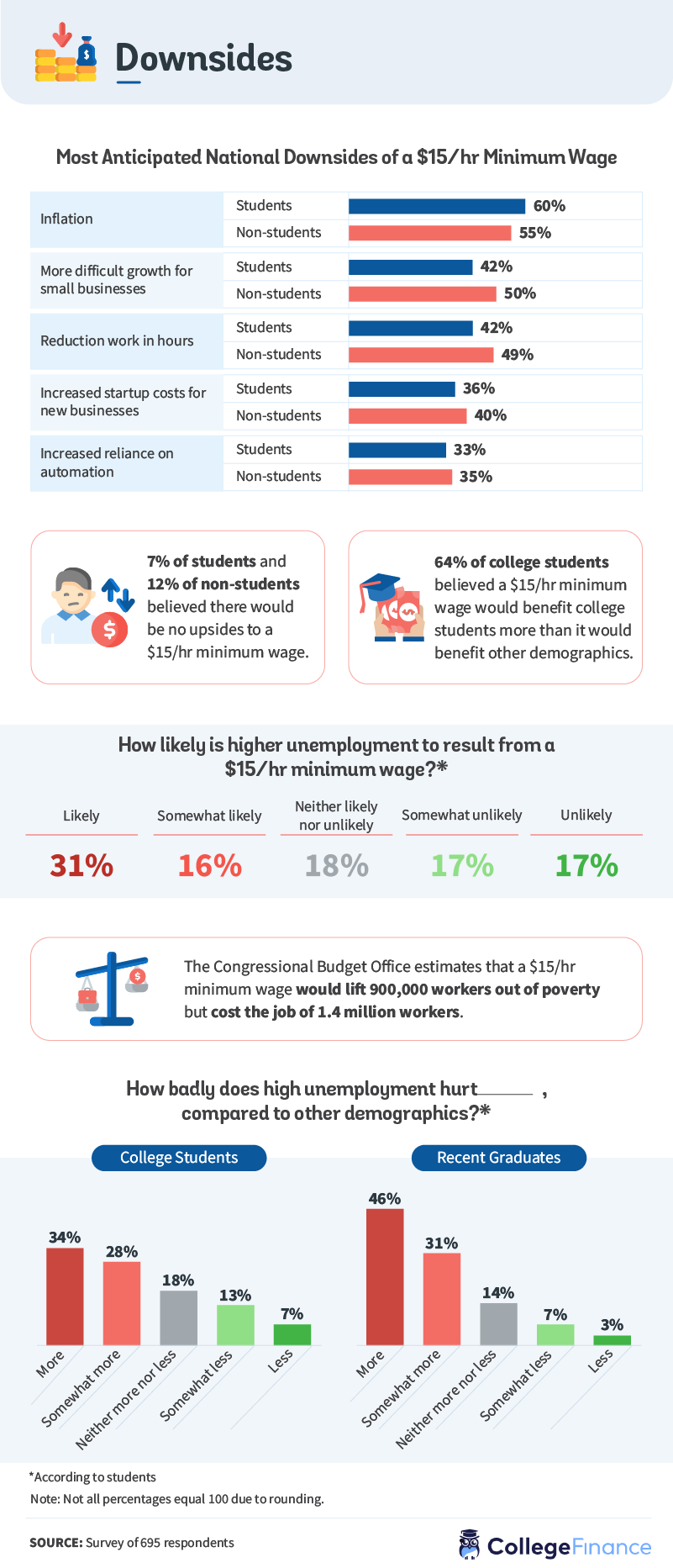Highlights:
- College students overwhelmingly support minimum wage increases, with 39% strongly in favor, 27% in favor, and 13% at least somewhat in favor of a $15/hr minimum wage.
- If their income were raised to $15/hr, students currently making less would dedicate 79% of that new income to essentials and savings.
Graduating college and entering the job market can be a daunting experience, even without the added pressures of a pandemic-ridden economy. On average, students today leave school with more than $29,000 in debt, heightening the demand to leave academia with a well-paying job lined up or even to work while they’re still in school.
And while experts say job outlooks are currently optimistic, it can be stressful to navigate the market with little to no real-world experience to count on. New grads may have missed the opportunity to partake in internships or working experience in 2020 as a result of the COVID-19 pandemic, instead relying on their academic accolades to land interviews and earn job offers.
So how does the idea of a $15 minimum wage affect college students, and how many believe it could improve their standard of living? To find out, we surveyed current students, recent graduates, and non-college students for their take on the political push to make a $15 minimum wage a reality for everyone. Read on as we explore how many students are familiar with the $15 minimum wage movement; how many support it; what the perceived ramifications could be; and how many would reduce their working hours if a $15 minimum wage were enacted.
Student Attitudes Toward a $15 Minimum Wage
While they might not be fully aware of every component of the $15 minimum wage movement, a majority of college students expressed their support for increasing the federal minimum wage.

In April 2021, President Biden enacted a $15 minimum wage for all U.S. federal contractors, an increase from the previous minimum of $10.95. In an effort to “address income inequality” across the country, Biden initially proposed raising the minimum wage to $15 for all workers as a part of his $1.9 trillion COVID-19 relief package, but this was later removed during the budget reconciliation process.
When asked about a $15 minimum wage for everyone, 39% of students said they were strongly in favor, followed by 27% who simply supported the idea and 13% who said they were somewhat in favor. In contrast, 5% of students were neutral on the idea of a $15 minimum wage, 8% somewhat opposed it, and 7% opposed or strongly opposed. As we found, non-students were less likely to strongly support a $15 minimum wage (32%) and more likely to oppose (10%) or strongly oppose it (7%). And while 55% of students were familiar with the $15 minimum wage movement, far fewer were familiar with recent congressional actions (29%) or the Congressional Budget Office’s (CBO) analysis on a minimum wage increase (23%). Students were also far more likely to be at least somewhat in favor of President Biden’s minimum wage proposal (54%), though a large number felt neutrally toward congressional actions regarding the $15 minimum wage movement (46%).
Anticipating Changes From a Higher Minimum Wage
A majority of college students reported earning less than $15 an hour at their current jobs and said the increase in their income would allow them to save and invest more than they were currently.

When asked about their own finances, more than 4 in 10 college students (44%) said they were currently making $15 an hour or more, though 8% said they were earning just $7.25 or less. The median college student surveyed reported an hourly wage of $13. A majority of students said they would work the same number of hours, even with the additional income they might get from a $15 minimum wage (53%), followed by 28% who would work less and earn the same amount and another 19% who would work more for the additional income.
Studies indicate that working while enrolled in college can hurt students more than it helps them, as their student employment doesn’t adequately prepare them for better jobs after college and takes time away from their studies. Among current students without jobs, 60% said they would be more likely to work for $15 an hour. All told, 16% of students acknowledged struggling financially.
While 56% of student income was currently spent on essentials, 22% went to nonessential purchases and 22% toward saving and investments. If their income were raised to $15 per hour, students making less than $15 said they would dedicate 35% of that additional income to saving and investments.
Positive Perceptions of a $15 Minimum Wage
Non-college students were less likely than current college students to report believing in the positive effects of a $15 minimum wage, though many still agreed it would lead to a higher quality of living.

Raising the minimum wage to $15 an hour would increase the compensation of 17 million workers across the U.S. As a majority of Americans earning at or below the current federal minimum wage of $7.25 are younger, we asked college students how an increase in the minimum wage to $15 would impact them personally. Twenty-six percent of students said a $15 minimum wage would be a very positive change, followed by 34% who said it would be positive, and 17% who said it would be somewhat positive. Just 12% of college students said a $15 minimum wage would have no impact on them. The most anticipated benefits of a higher minimum wage included an improved standard of living (67%), more financial freedom (56%), the ability to save money (56%), and the opportunity to pay off student loans more easily (50%).
As we found, students were more likely than non-students to report a $15 minimum wage would have a positive impact on the lives of all Americans. Compared to 77% of students, just 72% said a $15 minimum wage would increase the standard of living for low-income workers. Non-students were also less likely to believe an increase in the minimum wage would stimulate the economy, less likely to believe it would lead to an increase in consumer spending, and less apt to believe raising the minimum wage would decrease dependency on government programs.
Negative Perceptions of a $15 Minimum Wage
Non-college students were also more likely to believe the negative consequences of raising the minimum wage to $15, and nearly 1 in 3 students agreed it would be at least somewhat likely to cause a higher unemployment rate.

Not all of the perceived effects of increasing the federal minimum wage to $15 have been positive, as some opponents argue small businesses may be unable to provide such dramatic increases to their employees with little ramp up. Among both students and non-students, the biggest expected potential national downside to a $15 minimum wage would be inflation.
Generally, non-students were more likely than current students to indicate the negative impact of an increase to the minimum wage, including more difficult growth for small businesses (an 8 percentage point difference), reduction in working hours (7 percentage points), increased start-up costs for new businesses (4 percentage points), and increased reliance on automation (2 percentage points). Compared to 7% of college students, 12% of non-students reported believing there would be no upsides to a $15 minimum wage.
While the CBO reports a $15 minimum wage could lift 900,000 Americans out of poverty, it could also cut jobs for 1.4 million workers if businesses are unable to afford the higher wages. Over a third of students (34%) believed a $15 minimum wage would likely lead to higher unemployment across the U.S. Overwhelmingly, students also indicated higher unemployment more likely affects recent graduates (46%) and current students (34%) than the average working American.
Navigating Finances and Student Life
Experts may not always recommend working while you’re in college if you can help it, but some students don’t have a choice. For those that have to balance their school load with the need for added income from working, an increase in the federal minimum wage to $15 could help them work less or earn more money for saving and investing. While non-students were less likely to see the upside, a majority of people surveyed acknowledged the national benefits of increasing the standard of living for low-income workers and economic stimulation.
At College Finance, our mission is simple: to help you get the most out of your college investment. By helping you compare private student loan offers, refinance student loans, shop for student credit cards, or find scholarships, we’re committed to helping you navigate the financial aspects of student life with options and transparency. Whether you need help planning for the future, borrowing for today, or repaying tomorrow, we make it easy to compare your options and make the best decisions possible. Learn more online at CollegeFinance.com today.
Methodology and Limitations
For this study, we surveyed 695 respondents, among whom 353 were current students. Our respondents ranged in age from 18 to 77 with an average age of approximately 33. Among our respondents, 317 were female, 361 were male, 5 were nonbinary, and 12 did not report their gender.
In some cases, questions and answers have been rephrased for clarity. These data rely on self-reporting. Potential issues with self-reported data include, but are not limited to, the following: attribution, exaggeration, telescoping, and selective memory.
Fair Use Statement
Are your readers interested in an increase to the federal minimum wage? We welcome the sharing of this report for any noncommercial use with the inclusion of a link back to this page so your readers have full access to our findings and survey methods.

